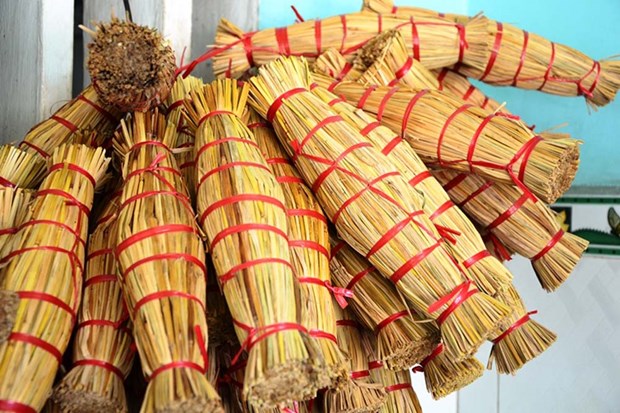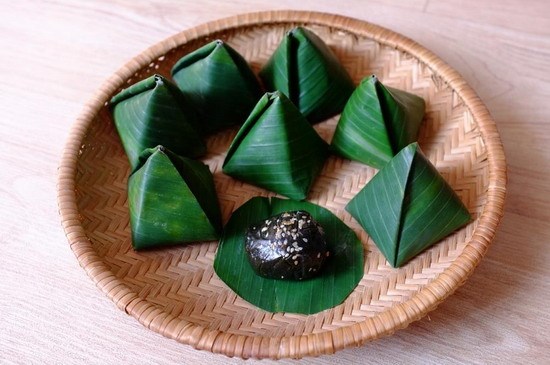If you are an avid traveler in Viet Nam, chances are you have heard of the Banh It Towers.

Last straws: Tré, a fermented pork dish made in Binh Dinh differs from elsewhere because its is wrapped in straw, making it look like a broom stick. — Photos: Bach Lien/VNS
The
complex of stunning temple towers date back a thousand years, to the days of
the Cham Dynasty. They are now a major symbol of the historical and cultural
attractions in central coastal province of Binh Dinh.
What
has this architectural marvel to do with food?
Nothing.
They
were originally called the “Silver towers” by French researchers, but the more
popular name, Banh it, has been passed through several generations of local
residents.
Why
did the locals name it after a dish then?
Surprisingly,
the answer is very simple.
It
is said that there was a woman named The Thien, who used to sell banh it at the
foot of the high mountain on which the famous towers stand.
Moreover,
the towers are shaped like elongated pyramids, somewhat like the cake, which is
made in a rather more compact pyramidal shape.
Over
centuries, banh it (full name: banh it la gai) has become an inseparable part
of Binh Dinh culture and the pride of its inhabitants.
The
sticky rice cakes with a coconut and green bean stuffing wrapped in a banana
leaf has become part of folklore.
A
popular saying goes: "If you wish to eat banh it la gai, get married to a
Binh Dinh man and enrich your life.”
While
it is said to have originated in Binh Dinh Province, the cake has become a
veritable specialty of the central coastal region.
The
cake has five ingredients: sticky rice, la gai (ramie leaf), sugar, green beans
and banana leaf.
Vo
Thi Bich Ngoc, owner of the Ba Du shop in Tuy Phuoc District, which specializes
in banh it la gai, said great care has to be taken through different stages to
make a good cake.
“First
of all, we wash the la gai (ramie leaves), boil them and grind them with a
stone mortar until their green colour turns black.
“After
that, we put sugar and the glutinous rice flour in the mortar and grind them with
the ramie leaves. Then the three ingredients are mixed together to make the
dough.
“The
dough is then steamed in a big pot with fire from firewood (not gas or
kerosene). When the dough is well done, we take small parts of the dough on a
pair of chopsticks and dry them over burning coal, so that the cake will be dry
and not sticky.”
The
dough is then divided into different small parts and stuffed with green beans
and shredded coconut.
“The
green beans have to be soaked in water for hours and whipped before steaming.
Then the well-done beans are ground and rolled into balls to be used as filling
for the dough,” Ngoc said.
The
banana leaves are usually quickly heated on fire or dipped in hot water to make
them soft, so that it is easier to wrap the cake.
Explaining
how important the dish was to locals, Ngoc said that during death
anniversaries, it is acceptable that no fish or meat was served, but banh it la
gai was a must.
In
traditional marriage rituals, a tray of this cake is the gift given by the
bride’s family to that of the groom. This is said to showcase the culinary
skill of the bride, who has made the cake together with other villagers.
Binh
Dinh people are so proud of that cake that they’ve made a stone model and
displayed it on the beach in Quy Nhon City.
Another specialty
Besides
the sweet cake, tré (a kind of fermented pork) is another important dish for
several central provinces, with each locality having its own distinct recipe.
While
most of the ingredients are similar, each version is a little different – a
little crispier there, a little sweeter here and a bit sour elsewhere. All
versions have one thing in common: they are all delicious.
The
tré in Binh Dinh has a unique shape. Covered with straw, it looks like a
broomstick.
“The
first time I passed through Binh Dinh on the 1A National Highway, I wondered
why so many small broom sticks were hung in front of many small shops”, recalled
a smiling Ngo Thanh Mi.
“It
was only later that I realised it was a familiar local dish, that delicious fermented
pork was hidden inside the straw,” the Hanoian said.
Tré
is made with pork ears, pig’s head, sesame, galangal root (rieng in
Vietnamese), chili and garlic.
Pork
is boiled and put it into cold water to prevent it from being sticky. It is
sliced into very small pieces, mixed with spices and covered with young guava
leaves. After that, they are packed under layers of straw for two or three
days, and the meat is fermented naturally, absorbing the spices.
The
strong smell of galangal, garlic and sesame fat, the sweet and sour fermented
meat and the flavour of guava leaves combine to impart a flavour that is
particular to central Viet Nam.
The
dish, served with herbs, pickles, sliced carrots, and fish sauce, is also a
must during festive days. The dish is highly favoured by men when they gather
with friends to drink the local Bầu Đá wine.
Next
time you enjoy Binh Dinh’s mountains, beaches and Cham towers, sample these two
delicacies to make it a really wholesome experience.

Special flavours: After uncovering the layers of straw, the tré exudes the combined flavours of spices, tender guava leaves and fermented pork.

Delicacy: Banh it la gai wins everyone over with the sweetness of sticky rice, coconut and green beans flavoured by ramie leaves (la gai).

Green pyramids: Banh it la gai wrapped in banana leaves. — Photo blogdulich.com
By Vuong Bach
Lien/ VNS